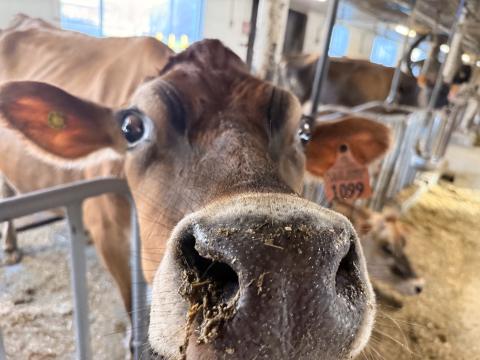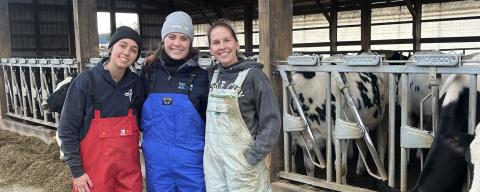Grafton County Farm Partners with UNH to Advance Cow Monitoring Technology
The Grafton County Farm, the last remaining county dairy farm in New Hampshire, has a long history of adapting and improving its operation. Established in the late 1800s in North Haverhill, the farm currently milks 60 Holstein and Jersey cows in a tie stall facility. Much of the daily work is done by inmates from the County Department of Corrections as part of a rehabilitation program that provides hands-on experience, life skills, and the opportunity for inmates to work off a percentage of their sentence.
Over the years, the Grafton County Farm has worked to modernize their dairy operation. This includes adopting artificial insemination, improving herd genetics, and increasing milk production averages. The farm’s dedication to herd improvement earned it the Holstein Association USA Herd of Excellence Award in 2017 and 2018.
The farm’s latest advancement is the addition of SmaXtec, an advanced cow monitoring system. The SmaXtec technology uses boluses, small devices administered to the cows that will stay in their reticulum, a chamber in the cow’s stomach, for life. These boluses are given to the animals when they reach puberty and measure inner body temperature, water intake, rumination, and activity. This information is transmitted through cellular service to a base station that also records outside temperature and humidity. This data provides a detailed picture of each cow’s health and behavior.
With this system, farm staff can identify animals in heat, reducing the amount of time spent on visual heat detection and minimizing the use of synchronization drugs. The data is also used to improve the farm’s nutrition by providing information on rumination activity and water intake. The SmaXtec system can also detect early signs of illness, often before there are visible signs, allowing workers to intervene sooner and improve animal welfare and reduce disease impacts.
This project is part of a collaboration with University of New Hampshire College of Life Sciences and Agriculture, led by Dr. Claira Seely and supported by a USDA grant. Dr. Seely’s team has implemented SmaXtec systems at the UNH Fairchild Dairy Teaching and Research Center, the UNH Organic Dairy Research Farm, and now the Grafton County Farm. The research aims to better understand how animal behavior and rumination relate to health, feeding, and environmental conditions. This information will ultimately help dairy producers make data-driven management decisions.

Through this partnership, the farm will also work with UNH Cooperative Extension to evaluate how monitoring technologies affect management, labor, and cow performance. These insights will help other New Hampshire dairy producers who are looking at purchasing similar technologies.
The Grafton County Farm has partnered with UNH for years, such as serving as a host site for a dairy cattle health workshop this past summer. Its ongoing collaboration with UNH will continue to generate valuable knowledge about the adoption of precision technologies, benefiting dairy producers in New Hampshire and beyond.
Extension Services & Tools That Help NH Farmers Grow
Newsletters: Choose from our many newsletters for production agriculture
Receive Pest Text Alerts - Text UNHIPM to (866) 645-7010



